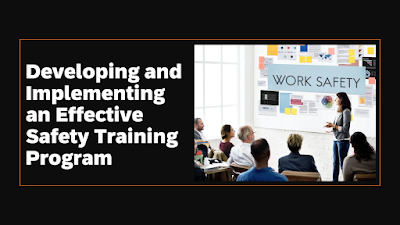Developing and Implementing an
Effective Safety Training Program
Workplace safety is a
critical issue for employers and employees alike. Every year, thousands of
workers are injured or killed on the job, leading to significant financial
losses for employers and devastating consequences for workers and their
families. Fortunately, effective safety training programs can help prevent
workplace accidents and injuries. In this article, we will provide a
comprehensive guide to developing and implementing an effective safety training
program.
PERMIT TO WORK PTW WORK PERMIT
Why is Safety Training Important?
Before we dive into the details of developing a safety training program, it’s important to understand why such programs are necessary. The primary goal of safety training is to prevent workplace accidents and injuries. This is important for several reasons:
Human Cost: Workplace accidents and injuries can have devastating consequences for workers and their families. They can result in pain and suffering, disability, and even death.
Financial Cost: Workplace accidents and injuries can also be costly for employers. They can result in lost productivity, increased insurance premiums, and legal fees.
Legal Compliance: In
many jurisdictions, employers are legally required to provide safety training
to their employees. Failure to comply with these regulations can result in
fines, penalties, and even criminal charges.
Basics of Behavior Based Safety
Given these factors, it’s clear that safety training is a critical component of any workplace safety program. But what does an effective safety training program look like?
Developing an Effective
Safety Training Program
The following steps are essential to developing an effective safety training program:
Step 1: Identify the Training Needs
The first step in developing a safety training program is to identify the training needs. This involves assessing the risks associated with the workplace and determining what type of training is required to mitigate those risks. Some common hazards that may require training include:
Chemical hazards
Physical hazards (such
as moving machinery)
Biological hazards
(such as infectious diseases)
Environmental hazards
(such as extreme temperatures)
Ergonomic hazards (such
as repetitive motion injuries)
Once the hazards have been identified, the next step is to determine what type of training is required. This may include:
General safety training
Task-specific training
Equipment-specific
training
Emergency response
training
Step 2: Develop the Training Materials
Once the training needs have been identified, the next step is to develop the training materials. This may involve creating PowerPoint presentations, handouts, videos, or other materials that can be used to deliver the training content. It’s important to ensure that the training materials are engaging, interactive, and easy to understand.
Step 3: Deliver the Training
The next step is to deliver the training. This may involve conducting in-person training sessions, online training modules, or a combination of both. It’s important to ensure that the training is delivered in a way that is engaging, interactive, and effective. This may involve using real-life examples, case studies, or hands-on training exercises.
Step 4: Evaluate the Training
Once the training has
been delivered, the next step is to evaluate its effectiveness. This may
involve conducting assessments, surveys, or other forms of feedback to
determine whether the training was successful in achieving its objectives.
Based on the results of the evaluation, it may be necessary to make adjustments
to the training materials or delivery methods.
Electrical Extension Cord Safety
Implementing an
Effective Safety Training Program
In addition to developing a safety training program, it’s important to ensure that the program is implemented effectively. The following steps can help ensure that the program is successful:
Step 1: Communicate the Program to Employees
It’s important to communicate the safety training program to employees to ensure that they are aware of its existence and understand its importance. This may involve conducting a company-wide meeting, sending out an email, or posting information on the company’s intranet.
Step 2: Provide Adequate Resources
To ensure that the
safety training program is successful, it’s important to provide adequate
resources. This may include providing training materials, equipment, and
personnel to deliver the training. It’s also important to ensure that employees
have access to the resources they need to maintain a safe working environment,
such as personal protective equipment.
Safety Net Fall Protection Construction
Step 3: Establish Safety Procedures
In addition to providing safety training, it’s important to establish safety procedures to ensure that employees know how to work safely. This may involve creating written safety procedures for specific tasks or equipment, and ensuring that employees are trained on these procedures. It’s also important to regularly review and update safety procedures to ensure that they remain effective.
Step 4: Monitor and Evaluate the Program
Finally, it’s important
to monitor and evaluate the safety training program on an ongoing basis. This
may involve conducting regular safety audits, reviewing accident and injury
reports, and gathering feedback from employees. Based on the results of these
evaluations, it may be necessary to make adjustments to the safety training
program to ensure that it remains effective.
Part 2 ADNOC & GULF HSE Interview Q & A
Safe Guidelines for Scaffold Erection
Conclusion
Developing and implementing an effective safety training program is critical to
ensuring a safe working environment. By identifying training needs, developing
engaging training materials, delivering effective training, and monitoring and
evaluating the program on an ongoing basis, employers can help prevent
workplace accidents and injuries. By taking a proactive approach to workplace
safety, employers can not only protect their employees, but also avoid the
financial and legal consequences of workplace accidents and injuries.
Health Hazard – Blue | NFPA Hazard Diamond





No comments:
Post a Comment